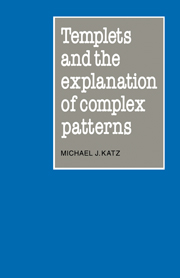Book contents
- Frontmatter
- Contents
- Prologue
- Introduction
- 1 Scientific abstractions
- 2 The nature of explanation
- 3 Configurational explanations
- 4 Templeting
- 5 Self-assembly
- 6 Rules for configurational explanations
- 7 Simple, complex and random
- 8 Reductionism
- Appendix: A pattern theoretic formalization
- Quotation index
- Subject index
7 - Simple, complex and random
Published online by Cambridge University Press: 26 March 2010
- Frontmatter
- Contents
- Prologue
- Introduction
- 1 Scientific abstractions
- 2 The nature of explanation
- 3 Configurational explanations
- 4 Templeting
- 5 Self-assembly
- 6 Rules for configurational explanations
- 7 Simple, complex and random
- 8 Reductionism
- Appendix: A pattern theoretic formalization
- Quotation index
- Subject index
Summary
One might say, from this more objective standpoint, we were two organisms. Two of those places where the universe makes a knot in itself, short-lived, complex structures of proteins that have to complicate themselves more and more in order to survive, until everything breaks and turns simple once again, the knot dissolved, the riddle gone.
[L. Gustafsson ‘Elegy for a dead labrador’, (trans: Y.L. Sandstroem) New Yorker, August 24, 1981, p. 34.]Simple and complex are two ends of a spectrum. Simple things have few parts, the parts are organized in a homogeneous fashion, and the whole can be fairly easily grasped in one fell swoop. Complex things have many parts, the parts are organized heterogeneously, and it takes a concentrated effort to comprehend the whole. A musical scale is simple, a Bach fugue is complex. A color chart is simple, a Jackson Pollock painting is complex. The alphabet is simple, the Bible is complex.
At times, the simplicity or complexity of an item can be deceptive. We sit down to a steaming meal of clams, lobster tails, crab legs, chicken, and vegetables. ‘Delicious, but obviously complicated to make,’ we comment to our host. ‘Not at all complicated,’ says he. ‘Your simply steam all of the ingredients in a large pot for an hour. The meal cooks itself.’ On the other hand, the first course was quenelle de brochette – egg-shaped fish mousses, looking like tiny homogeneous puddings.
- Type
- Chapter
- Information
- Templets and the Explanation of Complex Patterns , pp. 72 - 84Publisher: Cambridge University PressPrint publication year: 1986



